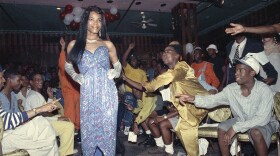The Kalamazoo State Theatre is turning 90 this year. To celebrate, the theatre will offer a host of events for Art Hop on September 8th from 5 p.m. to 9 p.m.
That includes an exhibit by Western Michigan University graduate student and Kalamazoo State Theatre intern Alicia Risk. Risk says she collected visitors’ memories about the State Theatre and will hang their quotes from the ceiling on foam boards.
“It’ll be a visual representation of 90 years of people’s thoughts and feelings and first dates and first loves and all that kind of stuff at the State Theatre,” she says.
The Kalamazoo State Theatre was made to look like a classical Spanish courtyard and is one of the few atmospheric type theatres in the U.S. today. Even the fire curtain is painted like a courtyard with a fruit stand and a fountain.
It was built in 1927 for $350,000. Local historian Sharon Ferraro says that would be about $5 million or $6 million today.
“Originally it would have been silent movies here because it was still the silent movie era in 1927 and so it could have been Charlie Chaplin. It could have been westerns, it could have been Douglas Fairbanks. You think of all the silent movie stars that we think of, they probably all came through here,” she says.
Today big movie theatres have multiple screens where they can show one film for weeks at a time. But Ferraro says early theatres only had one screen and would show about three different movies a week.
“So it was a very different way of going to the movies," she says. "There was no television, there was only radio. So this was what your major entertainment would have been over the weekend.”
Then there were the performances. Over the years the State Theatre has hosted many notable names - like jazz musician Duke Ellington, the comedians the Three Stooges, and famous Michigan magician Harry Blackstone.
“Magicians were always very popular. This stage was never a true, 100 percent vaudeville stage. So we wouldn’t have had dancing girls and all that kind of stuff, but there were a lot of different groups that came through town, traveling groups that would have come through. Maybe an occasional play,” says Ferraro.
By the 1930s, talkies had replaced silent movies in theatres. So the grand organ that played alongside silent films was retired. The organ doesn’t work anymore, but Executive Director Stephanie Hinman says it’s still hidden under the stage.
"This used to be a very grand experience because the organist would walk in from back stage and come and sit in the chair - and then you’d get ready to see the film and then a light would hit the organist and then it would rise out from the pit," says Hinman.
The organ is under the stage, but the pipes are one floor up on either side. You have to climb a ladder to get to them. Along the ladder there are tons of black hand prints.
"You’re looking at a time capsule. These are hand prints from the '20s of people who were working in the building and had to come up here to do maintenance," says Hinman.










